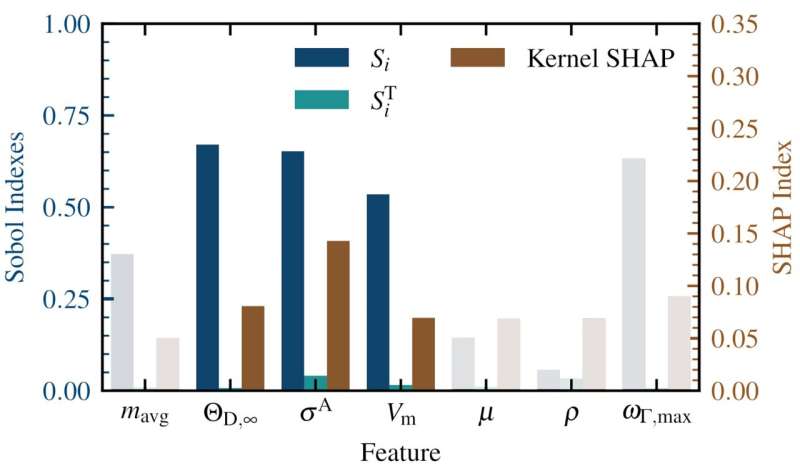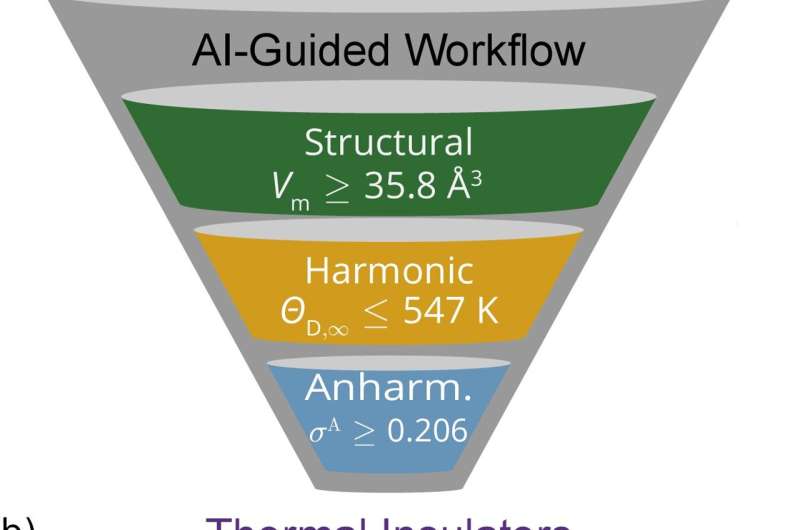This article has been reviewed according to Science X's editorial process and policies. Editors have highlighted the following attributes while ensuring the content's credibility:
fact-checked
trusted source
proofread
Efficient discovery of improved energy materials via a new AI-guided workflow

Scientists of the NOMAD Laboratory at the Fritz Haber Institute of the Max Planck Society recently proposed a workflow that can dramatically accelerate the search for novel materials with improved properties. They demonstrated the power of the approach by identifying more than 50 strongly thermally insulating materials. These can help alleviate the ongoing energy crisis, by allowing for more efficient thermoelectric elements, i.e., devices able to convert otherwise wasted heat into useful electrical voltage.
Discovering new and reliable thermoelectric materials is paramount for making use of the more than 40% of energy given off as waste heat globally and help mitigate the growing challenges of climate change. One way to increase the thermoelectric efficiency of a material is to reduce its thermal conductivity, κ, and thereby maintaining the temperature gradient needed to generate electricity.
However, the cost associated with studying these properties limited the computational and experimental investigations of κ to only a minute subset of all possible materials. A team of the NOMAD Laboratory recently made efforts to reduce these costs by creating an AI-guided workflow that hierarchically screens out materials to efficiently find new and better thermal insulators.
The work recently published in npj Computational Materials proposes a new way of using Artificial Intelligence (AI) to guide the high-throughput search for new materials. Instead of using physical/chemical intuition to screen out materials based on general, known or suspected trends, the new procedure learns the conditions that lead to the desired outcome with advanced AI methods. This work has the potential to quantify the search for new energy materials and increase the efficiency of these searches.
The first step in designing these workflows is to use advanced statistical and AI methods to approximate the target property of interest, κ in this case. To this end, the sure-independence screening and sparsifying operator (SISSO) approach is used. SISSO is a machine learning method that reveals the fundamental dependencies between different materials properties from a set of billions of possible expressions.

Compared to other "black-box" AI models, this approach is similarly accurate, but additionally yields analytic relationships between different material properties. This allows us to apply modern feature importance metrics to shed light on which material properties are the most important. In the case of κ, these are the molar volume, Vm; the high-temperature limit Debye Temperature, θD,∞; and the anharmonicity metric factor, σA.
Furthermore, the described statistical analysis allows to distill out rule-of-thumbs for the individual features that enable to a priori estimate the potential of material to be a thermal insulator. Working with the three most important primary features hence allowed to create AI-guided computational workflows for discovering new thermal insulators.
These workflows use state-of-the-art electronic structure programs to calculate each of the selected features. During each step materials were screened out that are unlikely to be good insulators based on their values of Vm, θD,∞, and σA. With this, it is possible to reduce the number of calculations needed to find thermally insulating materials by over two orders of magnitude.
In this work, this is demonstrated by identifying 96 thermal insulators (κ < 10 Wm-1K-1) in an initial set of 732 materials. The reliability of this approach was further verified by calculating κ for 4 of these predictions with highest possible accuracy.
Besides facilitating the active search for new thermoelectric materials, the formalisms proposed by the NOMAD team can be also applied to solve other urgent material science problems.
More information: Thomas A. R. Purcell et al, Accelerating materials-space exploration for thermal insulators by mapping materials properties via artificial intelligence, npj Computational Materials (2023). DOI: 10.1038/s41524-023-01063-y
Provided by Max Planck Society





















